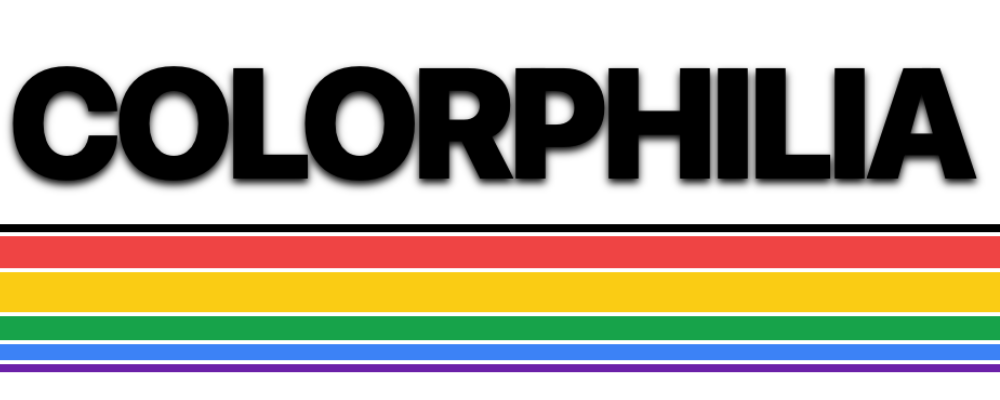Misreading the Absurd
I found a small error on a placard in the Jewish Museum in Rome.
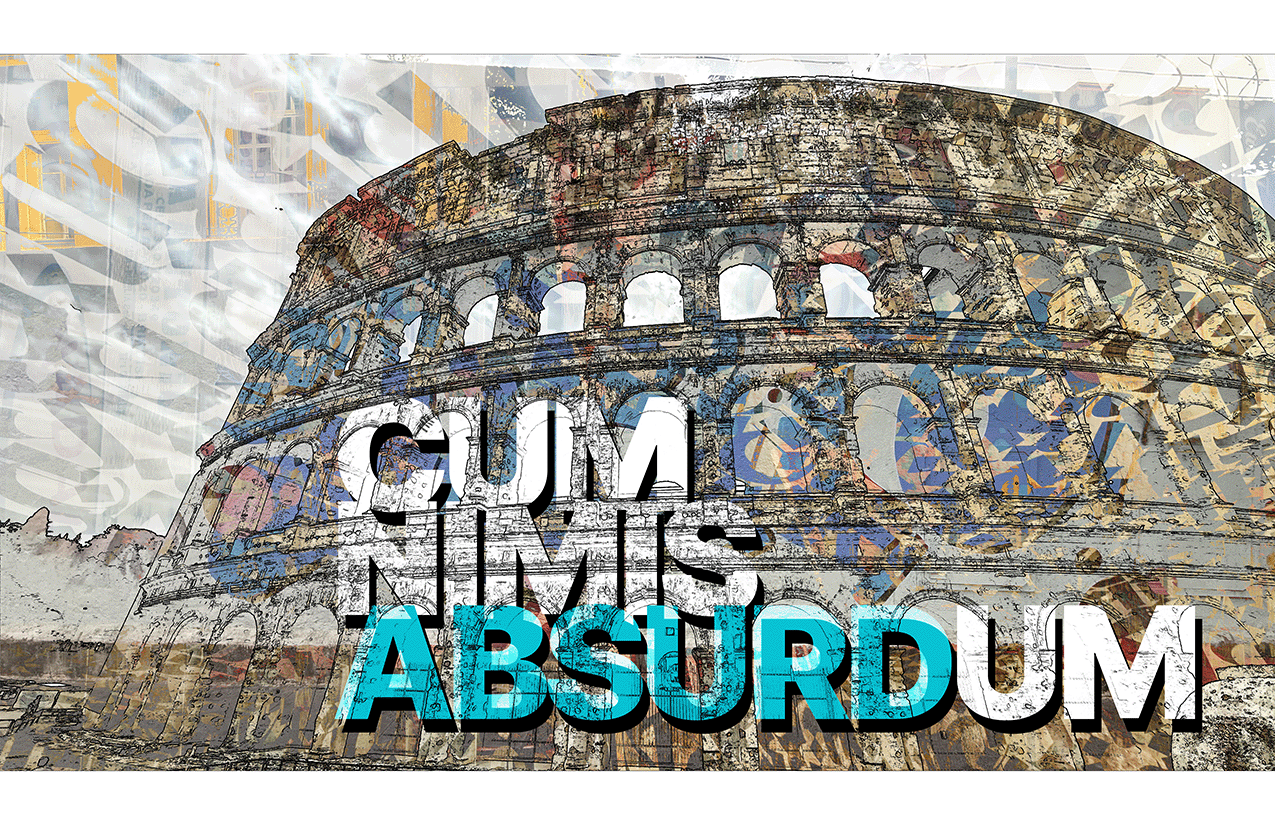
Ciao from Bologna, which is my final short stop in Italy, and the end of my "Summer of Curiosity" train tour.
Yesterday, I found myself in the Jewish Museum in the Roman Jewish Ghetto, and discovered a color-related mistake. I'm still not sure who originally made the mistake or when it originated.
It was on a placard next to a fascimile of a Latin 16th century anti-Jewish papal bull with an absurd name. The placard noted that Jews had to wear the color yellow.
Anyone who took the time to read the Latin original and knows anything about medieval color would recognize that the color glaucus is definitely not yellow, it's more of a green or blue-ish green. Maybe a light teal.
In this issue of the Colorphilia newsletter, you'll learn more than you really wanted to know about this mistake, with a few somewhat extensive, mostly color-related, tangents.
An Absurdity of Bigots
Even though I love the word "absurdity", I'm going to use here as a collective noun for a group of bigots. There is a lack of originality of thought which I wish to denigrate. (I mean no disrespect of true masters of the absurd, like the Spanish-Mexican filmmaker Luis Buñuel.)
Pope Paul IV
The Roman Jewish Ghetto was created because of a Papal Bull in 1555 by Pope Paul IV, forcing Jews to (among other things): live in cramped quarters in an isolated part of the city, wear certain colored clothing, not fraternize with Christians, be prohibited from owning land or certain professions, not work on Sundays or Christian holidays, and perhaps worst of all, only have a single synagogue.
This absurd document has an equally absurd title, taken from its first words: Cum nimis absurdum, Since it is completely absurd. At that point, Jews had lived in Rome for more than 1600 years, since before the common era, or as the Pope would have likely said, "ante Christum natum" or "Before Christ was born".
According to the trilingual museum placard, the required color of differentiation was yellow, which was wrong. I don't blame the museum staff or curators for the error, the Council of Centers on Jewish-Christian Relations has a similar translation of the full Papal Bull, which translates the first line of the third clause of the document as such (emphasis added in bold):
Moreover, concerning the matter that Jews should be recognizable everywhere: [to this end] men must wear a hat, women, indeed, some other evident sign, yellow in color, that must not be concealed or covered by any means, and must be tightly affixed [sewn];
Nazis & Fascists
It would be really nice if the color were yellow, because it would simply provide another thing the Nazis copied directly from the document, in addition, you know, to literally taking the name of the cramped Jewish neighborhood as the ghetto.
And that would provide a neat timeline from Cum nimis absurdum to Benito Mussolini's Leggi Razziali (Racial Laws) restricting civil rights of Italian Jews, banning books, stripping them of assets, confining them to cramped quarters, and ultimately, resulting in thousands of Roman Jews being murdered in Auschwitz-Birkenau.
The Leggi Razziali echoed Adolf Hitler's Nuremberg Laws, which included the Reich Citizenship Law and The Law for Protection of German Blood and German Honor. The latter of which, in the fourth clause forbids Jews from displaying the "Reich colors", but permits them to display the "Jewish colors".
What were Jewish colors? No one really knew what Jewish colors were and then someone named Martin Friedländer made a blau-weiß (blue and white) flag.
The Spanish Roots of Post-Inquisition Ethnic Bigotry
But the whole blood aspect of the Nuremberg Laws was taken from a completely different set of laws, that I've previously mentioned, the Spanish 15th and 16th century Estatutos de limpieza de sangre or "the cleanliness (read: purity) of blood laws". These were the laws that were put into place to ensure that the New Christians, even devout ones, could never forget their (second) place in society.
Somewhat related: it was my studies of the history of these laws with Professor Moises Orfali, originally from Madrid, that forced me to learn how to read texts in the languages that they are.
He had suggested a book for some paper I had to write and I still remember the conversation today. I said to him, "Professor, I read English, Hebrew, and French. Is there any translation available?" and he responded that as an academic you needed to be able to read whatever text in the original language.
I spent weeks with a Spanish language primer and dictionary, and more than just learning about the purity of blood laws, I learned the lesson about language which annoyingly pervades every Colorphilia newsletter. It was due to his advice that caused me to spend the following summer in an intensive Latin course and the summer after that studying ancient Greek.
It was that hard-acquired knowledge that made me automatically know that the origin of the phrase "blue bloods" couldn't have come from a Spanish "sangre azul", because the Spanish laws valued the symbolic cleanliness, not some color. I had even discovered a source last year which indicated that they preferred white wine for the sacrament.
According to my research, it most likely came from a French travel writer in 1821 who misheard the phrase "sangre su" as "sangre azul", and didn't understand that it was a shortening of the phrase "sangre su derecho" (your blood is your right).
17th century Connecticut Puritans
As I take this blue stroll down memory lane, I cannot forget the initial color-related subject I studied (but didn't write about) when starting Colorphilia. I was interested in understand the origin of the term, the "blue laws", which originated amongst the 17 century Connecticut Puritans who create a collection of laws based on the Bible.
The term was coined in the second half of the 18th century, by a English preacher whose grandparents had lived in the colonies and told him about the bloody atrocities the Connecticut Puritans had done against anyone who didn't believe like them. He called them the "Blue laws, ie. bloody laws". Why blue is a minced oath for bloody is a topic on its own.
The reason this is relevant here is because one of the "Blue Laws" forbade anyone (even non-Christians) to work on the Christian Sabbath. This law was used in the early 20th century United States as a way to hurt Sabbath-observing Jews, who wouldn't work on their Sabbath (Saturday) and then they weren't allowed to work on the Christian Sabbath (Sunday), and would end up getting fired.
The Color Glaucus.
If the color wasn't yellow, what was it?
Et ad hoc ut pro iudaeis ubique dignoscantur, masculi biretum, foeminae vero aliud signum patens, ita ut nullo modo celari aut abscondi possint, glauci coloris, palam deferre teneantur et adstricti sint;
My rough translation:
And so the Jews should be recognizable everywhere: men should wear hats, and women should wear some other clear sign, in a way that cannot be concealed or or hidden, in the color glaucus, it should be fixed and bound (sewn) so it would be worn openly.
The first Colorphilia newletter I wrote was concerning the color glaucus, a bluish-green color, which resembled the color of water and the color of eyes.
How could anyone make such a simple mistake?
The Italian word for the color yellow is giallo. The translator may have assumed that the gl- turned into a gi- , just like the Latin flor (for flower) turns into the Italian fior. So if you don't happen to research medieval color or subscribe to a newsletter about color, it's a mistake anyone could make.
Additionally, it is very possible for someone to easily conflate the various historical laws in other places which forced Jews to wear a yellow badge with the intent of Pope Paul IV, for example in 16th century Worms, Germany.
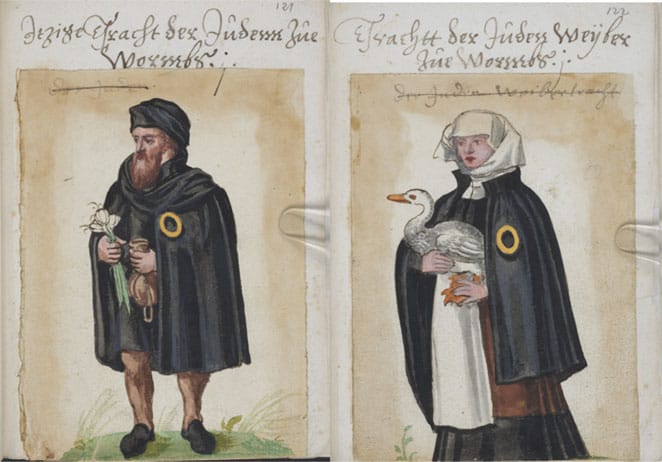
Why glaucus?
Shockingly, Pope Paul IV wasn't as original as one may think. He simply copied the thoughts set out by the Canons of the Twelfth Ecumenical Council or Lateran IV in 1215 headed by Pope Innocent III, who ruled in Canon 68, that:
In some provinces a difference in dress distinguishes the Jews or Saracens from the Christians, but in certain others such a confusion has grown up that they cannot be distinguished by any difference. Thus it happens at times that through error Christians have relations with the women of Jews or Saracens, and Jews and Saracens with Christian women. Therefore, that they may not, under pretext of error of this sort, excuse themselves in the future for the excesses of such prohibited intercourse, we decree that such Jews and Saracens of both sexes in every Christian province and at all times shall be marked off in the eyes of the public from other peoples through the character of their dress.
But there is interesting coda to this paragraph:
Particularly, since it may be read in the writings of Moses [Numbers 15:37-41], that this very law has been enjoined upon them.
The bracket in the Fordham sourcebooks refer to Numbers 15 (Translation JPS 1985, parentheses added)
38. Speak to the Israelite people and instruct them to make for themselves fringes on the corners of their garments throughout the ages; let them attach a cord of blue (tekhelet) to the fringe at each corner.
This explanation of "make Jews wear a light blue-green color which will really make their eyes pop, which in any event they are supposed to wear anyways" does not exculpate Pope Paul IV of absurdity. Jews would have to wear these clothing to attend mandatory sermons by Catholic preachers to be convinced to convert to Catholicism. "Force them to follow an overexaggerated version of their laws, until they decide to give up on all their laws" seems a tad extreme.
Back to the Biblical Blue, errr, Green, or maybe Blue-ish.
While my first official newletter topic was about glaucus, the second one was about translating biblical colors. A year ago, I wrote a Colorphilia newsletter about the color of the so-called biblical blue, tekhelet, in an attempt to correct some of my earlier mistakes. In it I created a historical timeline of how people translated the color. In the 11th and 12th centuries, the perception was the color of tekhelet was green. As I wrote in that newsletter:
I would suggest that Rashi assumed that tekhelet was a green color. This may be partially because in his commentary on Numbers 15:38, Rashi explicitly declares that “tekhelet: the green color of the ḥilazon”.
I have the suspicion that Pope Innocent III and the Lateran IV were not either the first to come up to originate the use of this color as a Jewish color.
The late 11th century Rashi and the late 12 century Midrash (Bamidbar Rabbah 18:3) both repeat the 8th/9th century Midrash (Tanhuma Korah 2:1) which in turn was quoting the 4th century Jerusalem Talmud (Sanhedrin 11:17) which uses the example of a "garment which is completely made of tekhelet" as an argument that Korah tried to make to usurp Moses' authority. It explicitly referred to Korah as an apikores (heretic).
The Midrash would often be used as way to surreptiously comment on contemporary issues without explicitly naming the parties. Something this newsletter would never do.
On the other hand, the Babylonian Talmud (Menachot 38) has a whole debate on the subject, including discussing the objective beauty of the garment, without calling anyone a heretic a single time.
Not everyone would have necessarily agreed with the exact hue. For example, a ca. 1247 (post-Lateran IV) Roman fresco I discovered from Danny Smith's research depicts an Italian Rabbi Zamri wearing a hat and a light blue-ish robe.
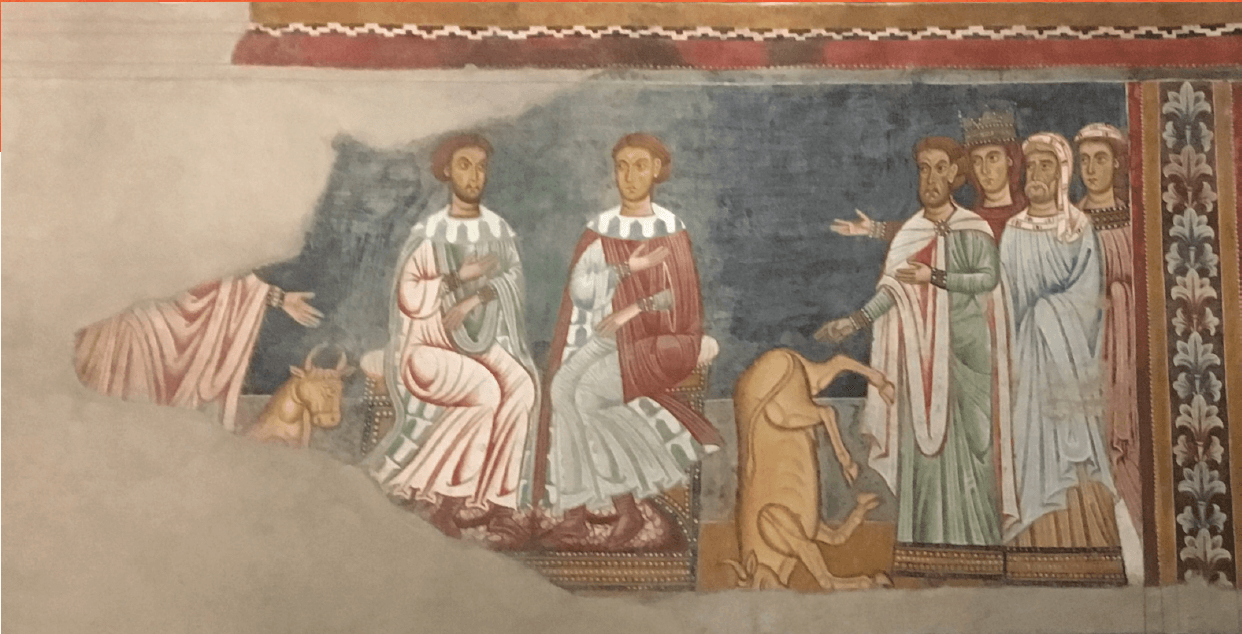
Inspiration
During this trip, I didn't visit the Sistine Chapel and take in the glory of Michelangelo's Soffitto (ceiling) depicting the Creation of Adam, among other things. Instead I had visited the Tempio Maggiore di Roma or the Great Synagogue of Rome which finished construction in 1904. As I stood in the center of the chapel and stared at the ceiling, I saw the stained glass interior of the aluminum dome, which featured a rainbow.
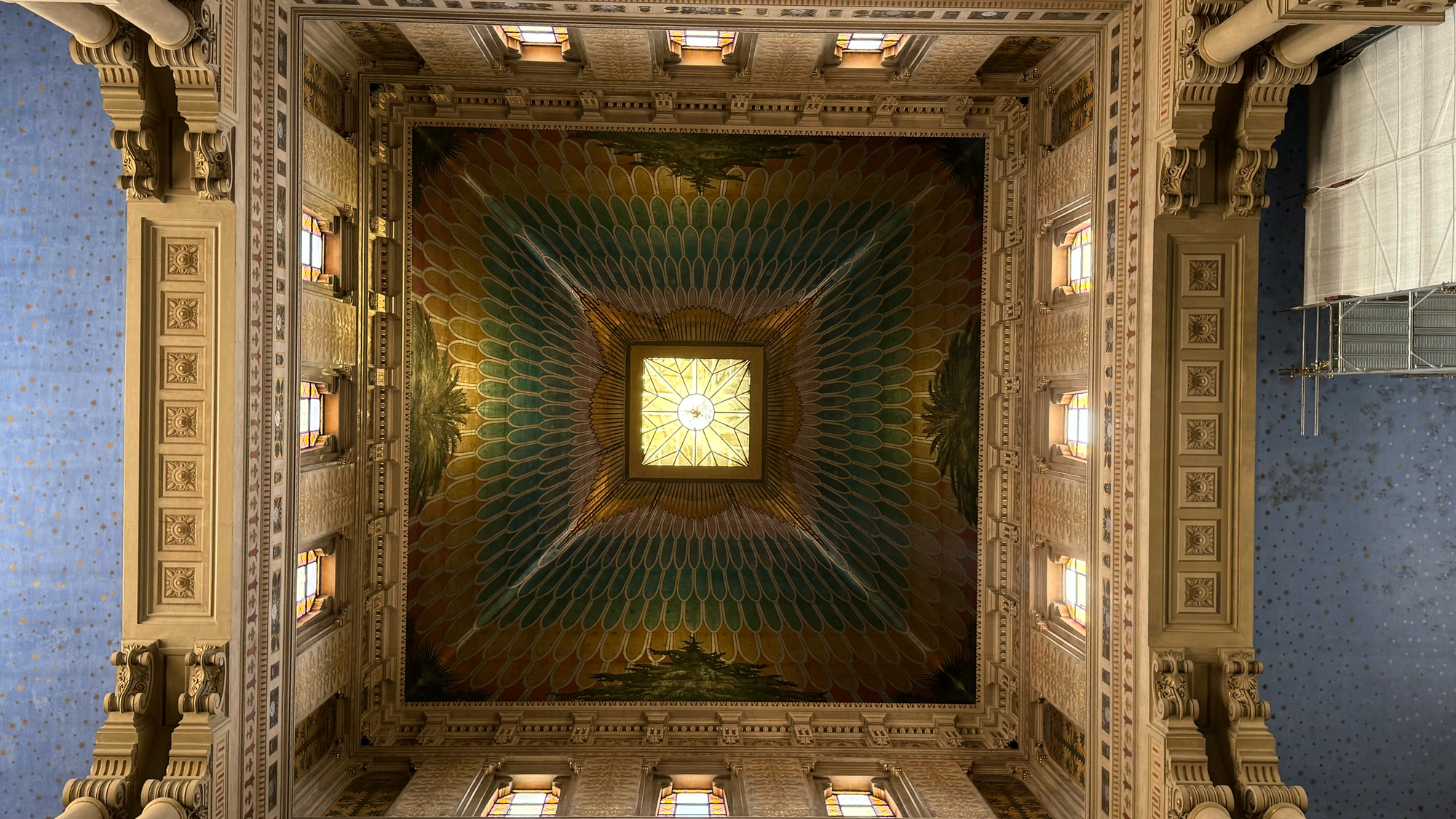
In Jewish law, there is a prohibition on figurative art. The explanation the guide had given was that the architects were able to take inspiration from Michelangelo and include the rainbow from the story of Noah. Personally, I think that there is a much better, albeit perhaps unintended, interpretation.
As I wrote in my Colorphilia newsletter about historical perceptions of rainbows, I mention how in Ezekiel used color words of sapphire (blue), amber (orange-ish), and fire (red) to describe the presence of God.
Like the appearance of the bow that shines in the clouds on a day of rain, such was the appearance of the surrounding radiance. That was the appearance of the semblance of the Presence of GOD.
Ezekiel 1:28 - JPS 2023 Translation
As I stood there and looked up at the rainbow skylight, I thought about my grandfather who prayed in the same synagogue as an American GI at the conclusion of WWII.
I read about how the Chief Rabbi Elio Toaff had embraced Pope John Paul II during the latter's visit to the Great Synagogue in 1986, which was, indeed, any reigning pope's first visit inside any Jewish house of worship.
Chief Rabbi Toaff, his father, his wife Lia, and his baby son Ariel were saved from the Nazis by the actions of various parish priests. And it was from Chief Rabbi Toaff's son, Professor Ariel Toaff, from whom I first learned about the history of Roman and Italian Jewry, and who has influenced so much of my research in the years since I studied under him.
Coda to my "Summer of Curiosity"
The Spanish philosopher George Santayana, who is buried in Rome, is often quoted with his aphorism "those who cannot remember the past are condemned to repeat it."
I've come to realize how much I disagree. I would contend that the ones who condemn others to repeat history are the ones who are simply copying the actions of the historical figures who they wish to emulate. There is a marked lack of curiosity or originality in anything they do. They study history for all the wrong reasons. They are trying to emulate people who've already lost. There is probably a term to describe them.
Learning history, for me, is not about simply being able to understand what people have done. It is possible to be inspired by the past and reinterpret without copying those who came before us verbatim. Reinterpretation can be an act of respect, not derision.
For example, when I wrote about the etymologies of bizzare, amarilla, lavanderia and mozzarella, it was to highlight the beauty of adaptation and how language evolves with cultural interactions. Each is common, everyday word whose etymology potentially reveals a much richer and fascinating history.
Just like Vincent van Gogh and his sunflowers, learning about them in a new language changed his perspective. This is why I've given my sunflower stickers to people I've met during the course of this summer.

I'm finishing this summer both thoroughly exhausted and brimming with ideas to explore in the coming weeks and months.
